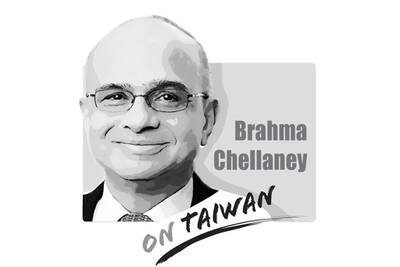Public participation in the selection of major national technologies should be based on accurate and complete information. This should be a matter of common sense when it comes to making science and technology policies in a democracy. The controversy over the nuclear power issue has been raging for more than 30 years in Taiwan. The problem lies in the frequent failures of the government, Taiwan Power Co and nuclear experts to provide accurate information about anything nuclear. Unfortunately, although the government has initiated a referendum on the construction of the Fourth Nuclear Power Plant in Gongliao District (貢寮), New Taipei City (新北市), this situation remains unchanged.
On Wednesday last week, TVBS broadcast a talk show discussing the nuclear power issue. When some of the guests argued over whether there was an appropriate site for the final storage of nuclear waste, National Tsing Hua University nuclear engineering professor Lee Min (李敏) said that US President Barack Obama terminated the Yucca Mountain nuclear waste repository project in Nevada for political reasons. According to Lee, the project was terminated because of the great influence of US Senate Majority Leader Harry Reid, who represents Nevada. Lee said the termination of the project was purely a political decision, and not a matter of the US being unable to find a proper site for the final disposal of nuclear waste.
However, on March 5, 2009, the New York Times ran a story titled “Future Dim for Nuclear Waste Repository,” reporting that the site for the repository had not been selected through a scientific process of elimination.
Instead, “it was selected from a list in 1987 by Congress, which declared it dry and remote enough ... Scientific concerns have since emerged, including the realization that water flows through Yucca Mountain a lot faster than initially believed. That raises the prospect that the nuclear waste would leach over time, polluting the water table,” the paper said.
In other words, the information provided by Lee was not complete, and it left the impression that the Obama administration’s decision to close the nuclear waste site was based purely on political reasons, rather than scientific ones.
The newspaper also reported that “the scientific merit of the site has not been established by independent judges.”
This is not to imply that Lee is lying. Indeed, in light of the strong opposition to the site among Yucca Mountain residents, Obama’s decision might well help him attract votes in Nevada. Still, let us not forget that there are no nuclear power plants in Nevada. The plan to build a nuclear waste repository there is similar to Taiwan’s disposal of nuclear waste on Lanyu (蘭嶼), where there also are no nuclear power plants.
We can learn two lessons from this. First, when scientific experts who are interested parties in the issue at hand blame an issue on political distortions of science and technology, the public needs to review all the related information with caution to avoid being misled.
The second lesson is that decisionmakers and scientific experts must remember that one important reason why nuclear power has lost public credibility in Taiwan is that supporters of nuclear power frequently provide incomplete, unclear and even inaccurate information.
Nevertheless, using information that is readily available in today’s Internet age, one-sided information can be easily exposed and rebutted.
Li Shang-jen is an associate research fellow at Academia Sinica’s Institute of History and Philology.
Translated by Eddy Chang

Donald Trump’s return to the White House has offered Taiwan a paradoxical mix of reassurance and risk. Trump’s visceral hostility toward China could reinforce deterrence in the Taiwan Strait. Yet his disdain for alliances and penchant for transactional bargaining threaten to erode what Taiwan needs most: a reliable US commitment. Taiwan’s security depends less on US power than on US reliability, but Trump is undermining the latter. Deterrence without credibility is a hollow shield. Trump’s China policy in his second term has oscillated wildly between confrontation and conciliation. One day, he threatens Beijing with “massive” tariffs and calls China America’s “greatest geopolitical
Chinese Nationalist Party (KMT) Chairwoman Cheng Li-wun (鄭麗文) made the astonishing assertion during an interview with Germany’s Deutsche Welle, published on Friday last week, that Russian President Vladimir Putin is not a dictator. She also essentially absolved Putin of blame for initiating the war in Ukraine. Commentators have since listed the reasons that Cheng’s assertion was not only absurd, but bordered on dangerous. Her claim is certainly absurd to the extent that there is no need to discuss the substance of it: It would be far more useful to assess what drove her to make the point and stick so
US President Donald Trump’s seemingly throwaway “Taiwan is Taiwan” statement has been appearing in headlines all over the media. Although it appears to have been made in passing, the comment nevertheless reveals something about Trump’s views and his understanding of Taiwan’s situation. In line with the Taiwan Relations Act, the US and Taiwan enjoy unofficial, but close economic, cultural and national defense ties. They lack official diplomatic relations, but maintain a partnership based on shared democratic values and strategic alignment. Excluding China, Taiwan maintains a level of diplomatic relations, official or otherwise, with many nations worldwide. It can be said that
The central bank has launched a redesign of the New Taiwan dollar banknotes, prompting questions from Chinese Nationalist Party (KMT) legislators — “Are we not promoting digital payments? Why spend NT$5 billion on a redesign?” Many assume that cash will disappear in the digital age, but they forget that it represents the ultimate trust in the system. Banknotes do not become obsolete, they do not crash, they cannot be frozen and they leave no record of transactions. They remain the cleanest means of exchange in a free society. In a fully digitized world, every purchase, donation and action leaves behind data.